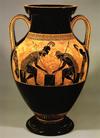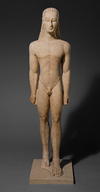Test 2 Flashcards
(25 cards)

Figure of a Woman
Cycladic Aegean
Marble
Simplified and stylized female figure
Not able to stand on its own
About a foot tall and thin
Bodies are based on three circles
Originally painted with rich mineral based pigments in asymmetrical designs
Most found at gravesite

Bull Leaping
Minoan Aegean
Wall painting
24 inches tall
Found in courtyard with other paintings all featuring bulls and people
Bulls seen as powerful and verile and prevalent in Minoan art
Possibly cult ritual assiciated with nature of verility
Figures shown in profile and are more naturalistic
Women - lighter, Men - darker

Funerary Krater
Geometric Greek
Ceramic
42 inches tall
Held ashes
Imagery arranged in registers
Memorial to the deceased
Humans reduced to geometric shapes
Upper register shows body layed out with mourners
Lower register shows military procession

Achilles and Ajax Playing a Game
Exekias
Archaic Greek
Ceramic
Image is associated with the Iliad by Homer
Shows them taking a break during battle
They are the first and second most powerul warriors
Image is balanced and symmetrical
Spears make vertical lines to direct our eyes
Shields used as borders to keep our attention
Shows Sophrosyne - Stoic, reserved, self control

Metropolitan Kouros
Archaic Greek
Marble
Similar features to Egyptian sculpture
Originally painted so less carved details
Body reduced to geometric forms
Long hair represents upper class
Iliac crest by hipbone reduced to two lines
Archaic smile - flat and unnatural looking
Made for commemorative purpose
Doesn’t depict a real person
Possibly a grave marker or votive figure to commemorate athletes

Parthenon
Kallikrates and Iktinos
Classical Greek
Named for goddess Athena Parthenos
Patron was city of Athens
Made from marble quaried two miles away
Idea of stone building adopted from Egyptians
Temple front facade: Column, entablature, and pediment
Post and lintel architecture
Uses doric columns
One room, cella, with statue of the deity
Cella door opens to the East
Statue is of Athena holding Nike, the goddess of victory
Normal people are not allowed to enter, meant to admire ouside sculptures
Parthenon uses optical illusons to create perfect shape
Building bows up in the middle to conteract sagging
Outer columns are slightly thicker and closer
Columns lean in so they don’t appear to be falling out
East pediment shows birth of Athena
West pediment shows battle of Athena and Poseidon

Spear Bearer
Polykleitos
Classical Greek
Marble (origially bronze)
Contropposte stance - shift in weight that implies naturalism
Idealized male figure, not a real person
Sopphrosyne - Stoic, reserved, self control
Arete - Personal excellence
Possibly visual demonstration of perfect male proportions

Aphrodite of Knidos
Praxiteles
Classical Greek
Marble
First important Greek female nude
Modest pose with hand over pubic area
Idealized female figure as young, toned and muscular, high breasts, tapered waist, hairless, and understated genitals
Establishes a new canon that priveledges the female nude over the male nude

Laocoön and His Sons
Hagesandros, Polydorus, and Athanadoros of Rhodes
Helenistic Greek
Marble (Possibly originally bronze)
Shows Lacoön and his sons being attacked by sea serpents
Emotional, not showing sophorosyne
Dynamic peice in motion
Shows human agony and suffering

Augustus of Primaporta
Roman Empire
Marble (Copy of bronze)
Realistic likeness but stightly idealized with younger age and muscle tone
Small figure is of Cupid riding a dolphin to link himself to Venus and thus devinity
Rome is a unified empire shown by the breastplate (cuirass) which shows the area granted to him by the gods.
Contrapposte - shift in weight that implies naturalism
Sopphrosyne - Stoic, reserved, self control
Not wearing shoes as idea he is standing on holy ground
Sculpture is highly propoganistic

Intiation Rites of the Cult of Bacchus
Roman Empire
Wall Painting
Survived in Pompeii due to eruption of Vesuvius
Located at the Villa of the Mysteries
Images show the intiation rites of a mystery cult

Column of Trajan
Roman Empire
125 feet tall
Monument for military victory of Dacia (Romania)
Reliefs are naturalistic
Spiral staircase inside leads to viewing platform on top

Pantheon
Roman Empire
Dedicated to all the major gods of ancient Rome
Build under reign of Emperor Hadrian
Orginally had walls and a forecourt with rows of columns
Coming up to the front you would have only seen the temple front facade
Corinthian columns
Interior has vast circular space with monumental dome (143 feet high and across)
30 feet wide hole on top represents eye of Jupiter
Walls have false windows covered in colored marble
Made of lightweight volcanic rock concrete
Dome shape symbolic of the heavens

Equestrian Statue of Marcus Aurelias
Roman Empire
Bronze
Only surviving bronze statue of antiquity due to mistaken identity (Constantine)
Wearing a beard to show himself as a mature and wise philisopher
Slightly larger than the horse to show greatness
Acurate portrait that shows his personality
Expresses that he is an effective leader that can rule without force (no weapons)
Extended arm shows clemency (mercy or lenience)

Arch of Constantine
Roman Empire
Commemorates victory of Maxentius
Triumphal arch - engaged columns, entablature, sculptural relief
Reliefs taken from monuments from the five good emperors and reused
New reliefs are not realistic with no depth
People are in simplified blocky form with no recognizable faces
Ephasis is on the greater scene rather than the individuals
Cycladic
c. 2500-1900 BCE
Minoan
c. 2000-1400 BCE
Mycenean
c. 1600-1100 BCE
Geometric
900-700 BCE
Oriental
700-625 BCE
Archaic
600-480 BCE
Classical
480-320 BCE
Hellenistic
320-100 BCE
Roman Republic
509-27 BCE


